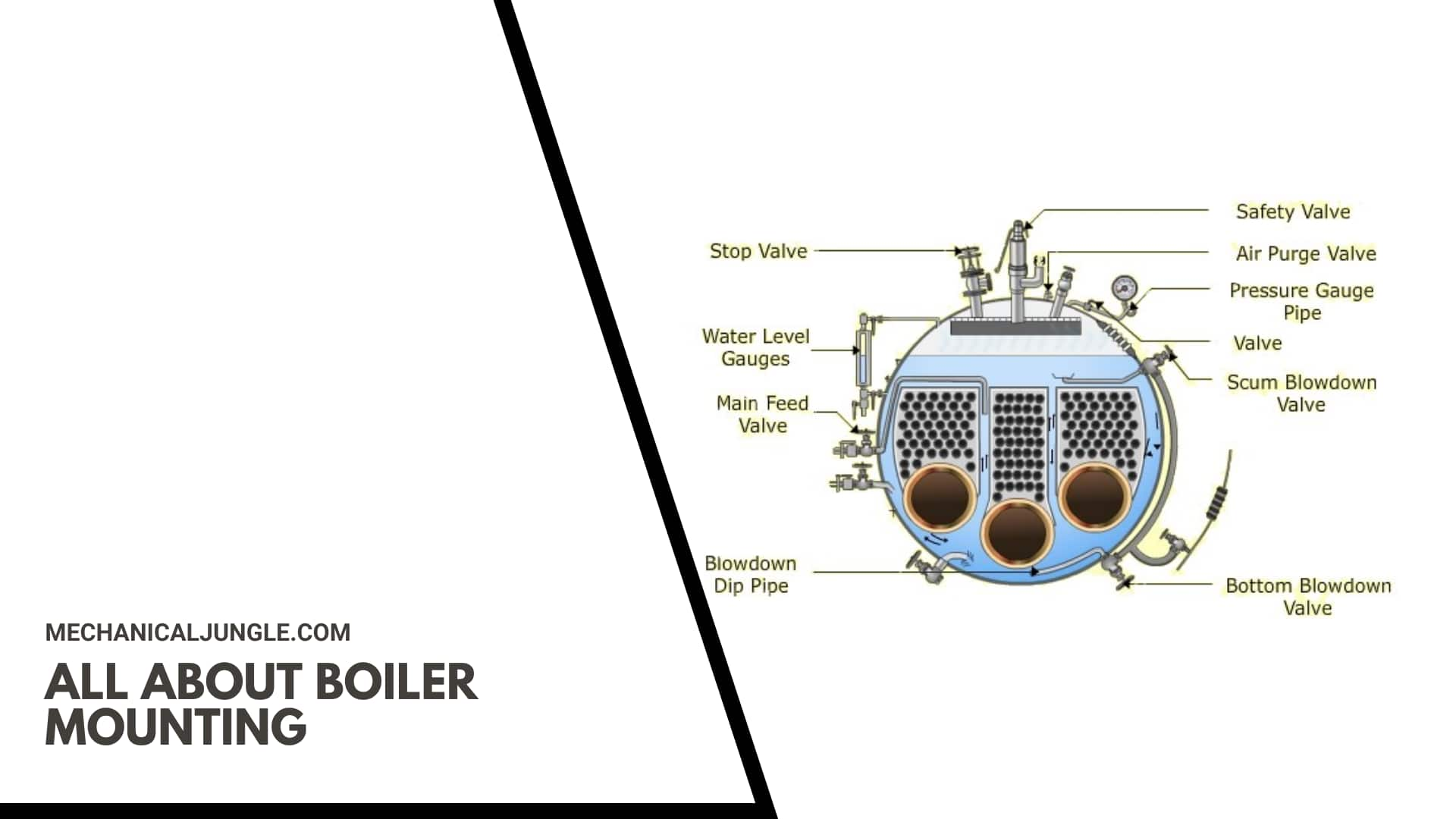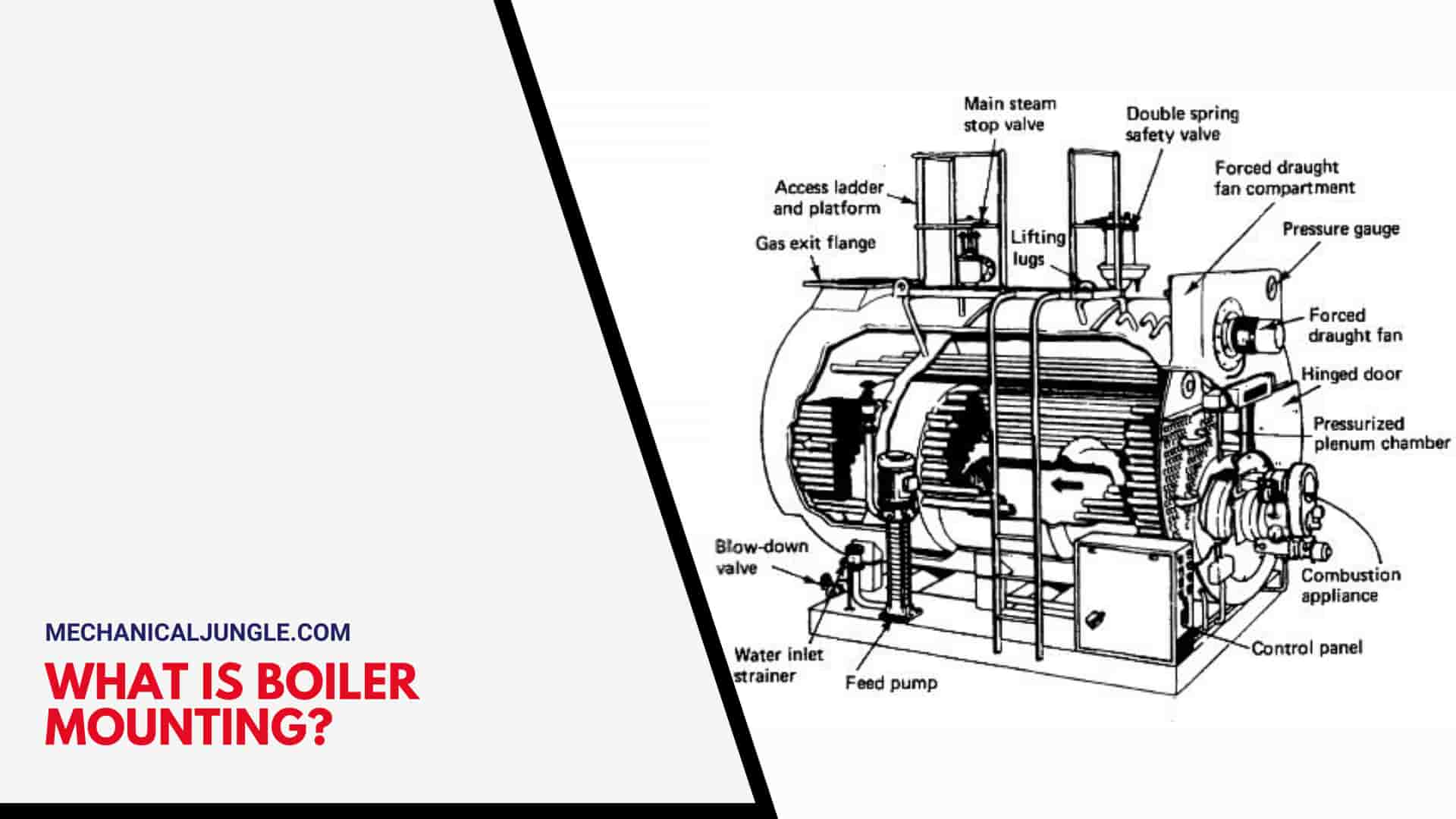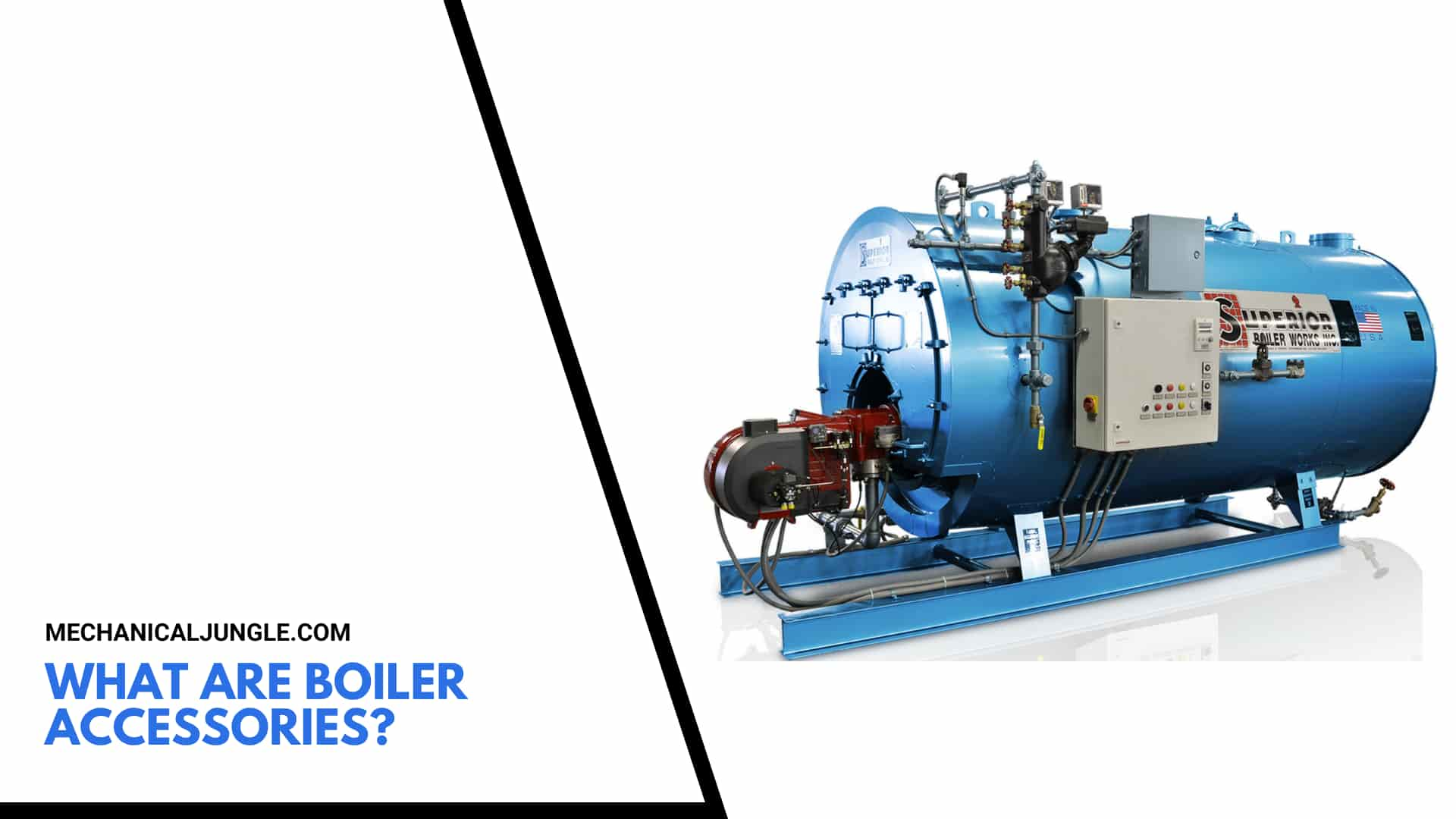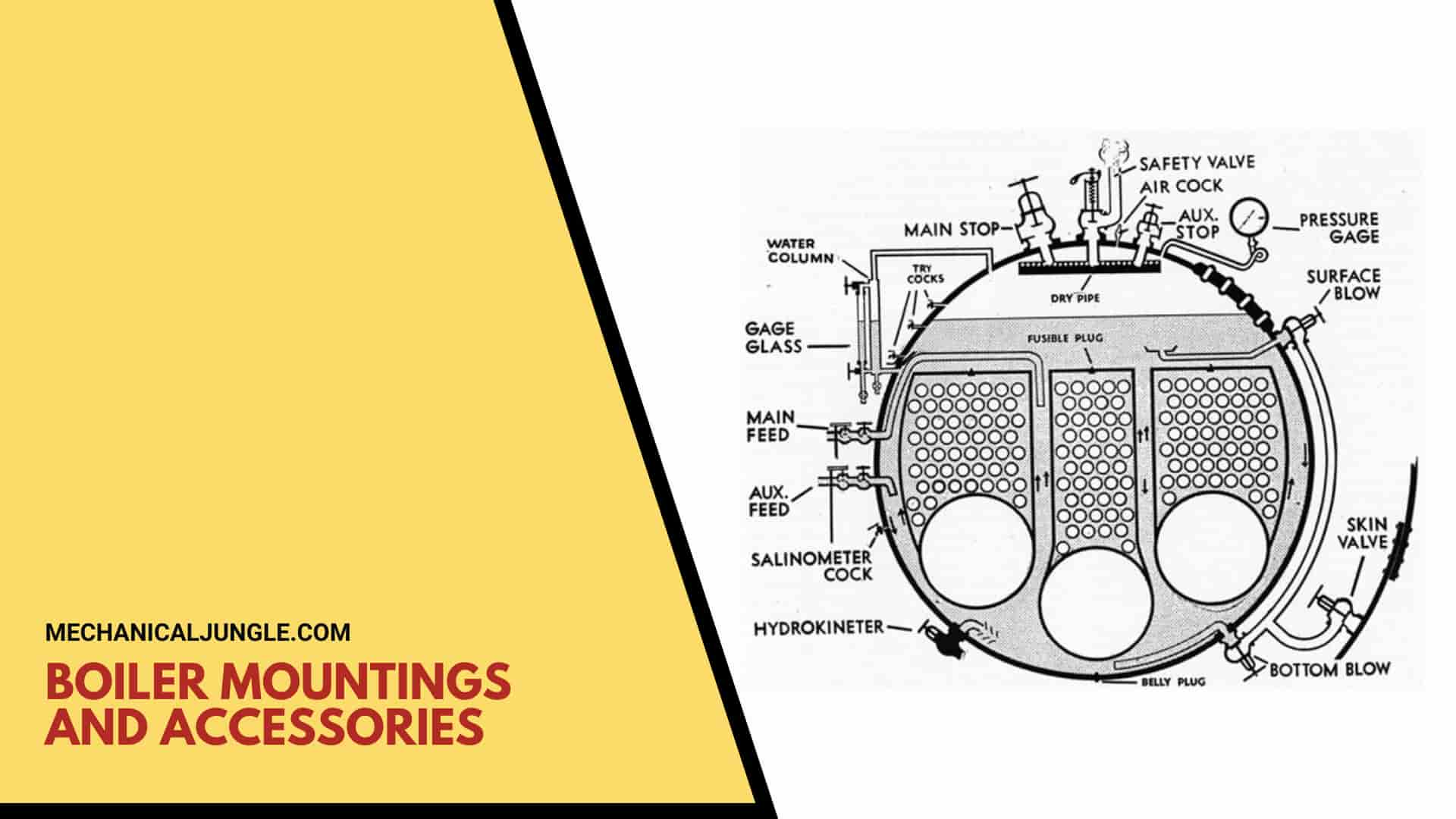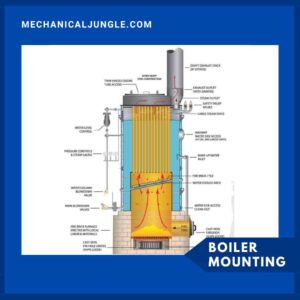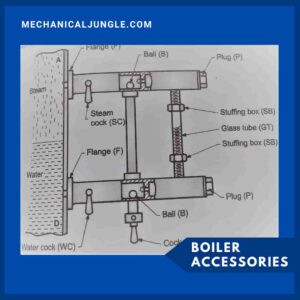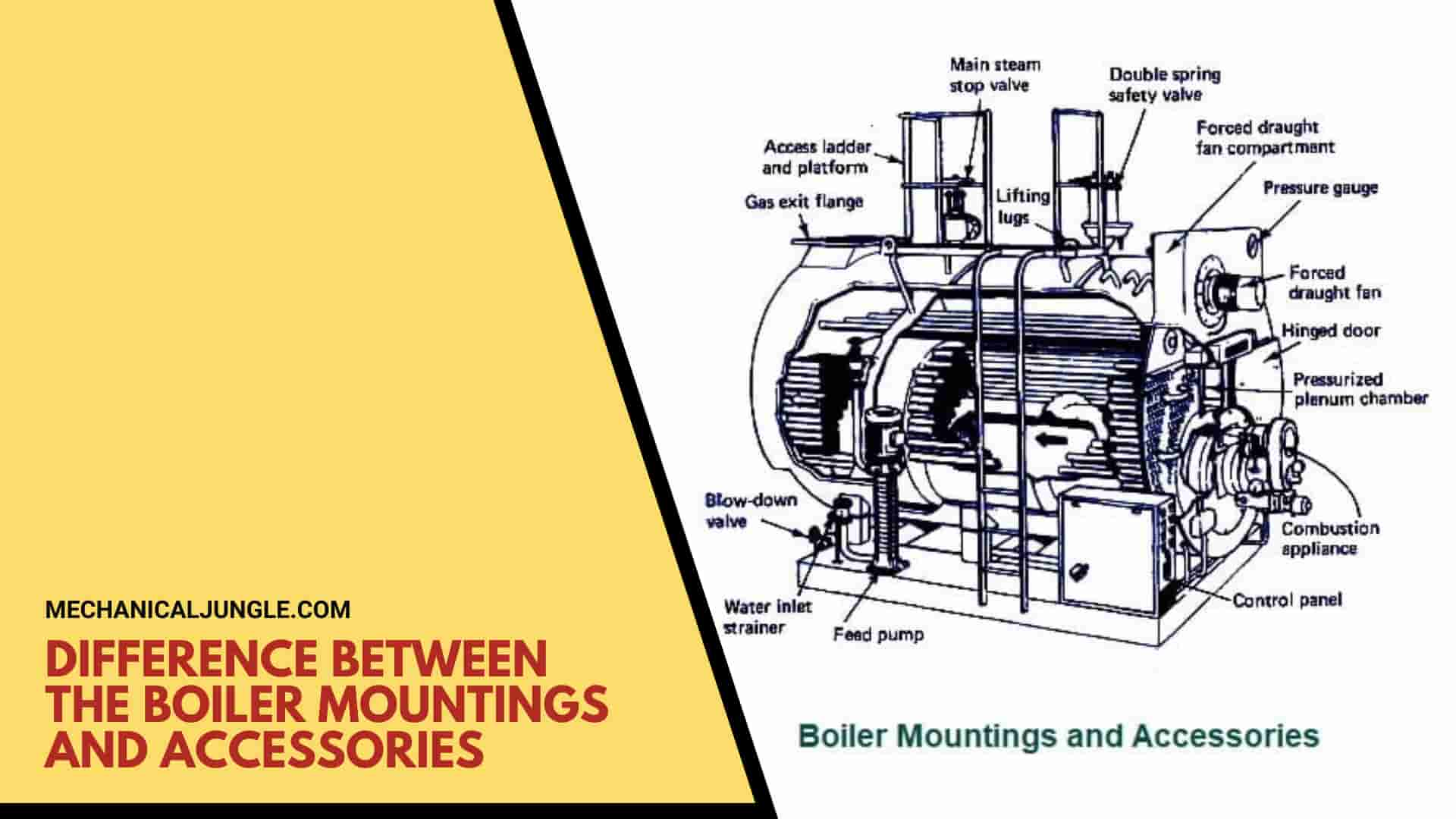Important Point
What Is Boiler Mounting?
Boiler mountings are mechanical devices that are considered necessary to operate the boiler smoothly & safely, which are usually mounted on surfaces of the boilers.
These mountings play a crucial role in understanding the difference between boiler mountings and accessories.
These are the parts of the system that are mounted on the boiler’s own body for protection of the boiler and for complete control of the steam generation cycle.
Machinery protects the boiler from damage to itself due to extremely high pressure, steam backflow, vacuum shell collapse, irregular steam pressure, low water, pumping backflow, and dry running.
Also, Read: What Is a CNC Machine? | CNC Block Diagram | Parts of CNC Machine
What Are Boiler Accessories?
When we talk about what is boiler accessories, we refer to devices and plants that are installed with boilers to improve the operating condition and overall efficiency of the boiler plant.
Boiler accessories are devices that are installed along the boiler and the surrounding area to increase the efficiency of the boiler.
These are not an indispensable part of the boiler, and thus without installing these devices, the boiler operation can be completed at low efficiency.
Boiler Mountings and Accessories:
Now, when we delve into the difference between mounting and accessories, let’s discuss different types of boiler mounting and accessories.
- Boiler Mounting.
- Boiler Accessories.
#1. Boiler Mounting
1. Main Steam Stop Valve
It is usually applied to the highest part of the shell through the flanges. To control the flow of steams from the boilers to the main steam pipe.
The steam produced in the boilers is provided by this valve to the ship’s system to completely shut off the steam when required.
It is typically a non-return valve type installed directly at the steam location of the boiler shells. The body is made of cast irons, & the valve seat is made of gunmetal.
2. Auxiliary Steam Stop Valve
A separate steam line provided by the boilers for the small auxiliary system is supplied to most steam systems on ships through this valve. The valve is small in size and is generally a non-return type.
3. Safety Valve
Location It is attached to boiler mounting steam chests. Function To blow off steam to prevent explosions when the steam pressure inside the boiler exceeds the working pressure.
Commonly used safety valves are spring-loaded safety valves. In case of unsafe excess pressures inside the boilers, a safety valve is used to release the excess pressure.
Before installation, the lifting pressure of the valve is set & locked in the presence of surveyors so that it does not change later. In generals, safety valves are fitted in pairs.
4. Scum Blowdown Valves
Location: It is mounted in the crown plate of a boiler mounting furnace or firebox.
Functions: To extinguish a fire in a boiler furnace when the water level in the boiler falls to an unsafe limit, and thus the explosion caused by overheating of the furnace plate is avoided.
A shallow dish types systems equipped at ordinary water level enables floating impurities, oil foaming, etc., to float from the surface of the water.
5. Salinometer valve
Location: The sampling water cock system is usually equipped with a cooler in order so that water samples can be collected at any time for testing the feed water.
Functions: To test the salinity of the water.
6. Whistle Valve
If a steam whistle is applied to the ship, the steam is supplied directly from the boiler, in the form of a small non-return valve known as the whistle valve.
7. Soot Blower
Function: Required for soot blowing & pipe surface combustion products. It is operated by steams or compressed air.
8. Automatic Feed Water Regulator
Location: A device that is important and fit into the feed line
Functions: Automatic feed water regulator is one of the important boiler mountings to ensure a proper level of water under all load conditions. In boilers with high evaporation rates, several feed element water control systems are used.
9. Manhole
Function: The boiler consists of several manhole gates which enable inspection, cleaning, and maintenance of boiler tubes and internal components by the crew.
Location: Usually fitted in a gate steam drum and a water drum.
10. Mud box
Function: Earthen cans are used in boilers to collect mud (dirty impurities) from water drums.
Location: Fitted underwater drum.
11. TDS Sensor and Sample
Functions Most modern boilers are now equipped with this system for continuous monitoring of total dissolved solids in the boiler water.
The sensor compares the actual value to the setpoint, and if the value is higher, then an audio-visual alarm is given.
A manual blowdown introduces fresh feedwater into the system to reduce total dissolved solids content.
12. Water Level Gauge Glass
Location: This fitting can be seen in front of the boiler.
Function: This boiler mounting is fitted to indicate the water level inside the boiler. Gauge glasses are also fitted in pairs to manually monitor the water level inside the boiler tank.
The construction of gauge glass is chosen based on the pressure of the boiler.
13. Air vent cock
Location: It is fitted in valve headers, boiler drums, etc.
Function: To protect the boiler from bursting when depressurized or when steam pressure increases internally.
The word explosion is the opposite of explosion. In this situation, the pressure inside the boiler will be sufficiently reduced by atmospheric pressure to prevent the shell from bending inward; this boiler mounting is required.
14. Feed Check Valves and Controls
Location: It is fitted in the shell slightly below the normal water level of the boiler. It is a non-return valve fitted into a screw spindle to control the lift.
Functions: To regulate the water supply, which is pumped into the boiler by a feed pump.
This valve controls the supply of steams as required & is installed after the stop valves in both main and aux steam lines. They are non-return valves that have visible signs of open and near position.
15. Pressure Gauge Connection
Location: It is fixed on the fronts of the boilers.
Functions: To measure the pressure of steam inside a steam boiler.
This pressure gauge can be installed in superheaters, boiler drums, and wherever necessary to read pressure readings. Commonly used pressure gauges are the Bourdon type.
16. Blowdown Valve
Location: Blowdown is an important boiler mounting, which is located below the boiler.
Work: To evacuate the boiler whenever necessary and to remove soil, scale, or sediment deposited on the bottom of the boiler.
It is used when the chloride level becomes too high for thorough cleaning of the boiler or for water treatment of the boiler.
Also, Read: What Are Nuts? | What Are Bolts? | Difference Between Nuts and Bolts
#2. Boiler Accessories
1. Feed Pump
Feed Pumps Are Used to Feed High-Pressure Water in Boilers. The Steam Pressure Inside the Boiler Is High, So the Feed Water Pressure Must Be Increased for Smooth Operation Before Reaching the Boiler.
in General, the Feed Water Pressure Is 20% Higher Than the Boiler Pressure. The Feed Pump May Be of a Centrifugal or Reciprocating Type.
2. Soot Blower
During combustion, soot accumulates on the inner tubes of the furnace, and the gas passes are plugged in.
Ultimately, soot deposited inside the furnace reduces the efficiency of the boiler. A soot blower is used to remove the soot from the tubes to prevent the gas pass from being plugged.
3. Injector
The function of the injectors is the same as that of the feed pumps; It is used where space is not available for the installation of the feed pump.
The kinetic energy of steam in an injector is used to increase the pressure and velocity of feed water in a convergent-diverging nozzle.
Advantage of Injector
- Simplicity,
- Density,
- High thermal efficiency,
- Lack of dynamic part.
Disadvantages of Injector
- Low pumping efficiency,
- Difficulty in operation under extreme variations in steam pressure.
4. Superheater
The superheater raises the temperature of saturated steam without increasing its pressure. It consists of a small bundle of tubes.
It is set in the path of the hot flue gas of the furnace. Saturated steam passes inside the heater tubes, and hot flue gases pass outside the tubes.
Thus the transfer of heat takes place in saturated steam from hot flue gases and raises its temperature without increasing the pressure of steam.
For this purpose, convection superheaters and radiation superheaters are used. The change in steam temperature depends on the position of the superheater, the temperature of the hot flue gases, the configuration of the superheater, and the flow of steam.
If the temperature of the saturated steam rises to 100C with the help of a superheater, then a 1 percent saving of fuel can be achieved.
Advantage of Superheater
- Steam consumption reduced.
- Protection from turbine corrosion.
- The losses from the condensation of steam in cylinders and pipes are reduced.
- Increases efficiency of plants.
5. Air Preheater
The air preheater is used to recover heat from the exhaust flue gases. It is established between the chimney and the economist.
Through the preheater, air passes for combustion purposes. This increases the temperature of the combustion air with the help of exhaust flue gases.
The air passes through the heater tubes, and the flue gas passes through the outside of the heater tubes.
Thus, heat is transferred from the flue gases to the air required for combustion.
If the temperature of the combustion air rises to 1000F with the help of an air preheater, 2.3 to 2.6 percent of fuel can be saved. In some situations, 5% to 10% of fuel savings can also be achieved.
Advantage of Air Preheater
- The evaporative capacity per kilogram of fuel increases.
- For every 35-400C increase in air temperature, the boiler increases 2 percent of efficiency.
- It Burns better with less smoke, soot, and ash.
- Allows low-grade fuel to burn with less excess air.
6. Pressure Reducing Valve
The function of a pressure-reducing valve is to maintain constant pressure on the distribution side of the boiler regardless of its pressure.
7. Steam Separator
In turbines, the use of wet steam is unviable; Therefore, a steam separator, also known as a moisture separator, is used.
The function of the steam separator is to remove water droplets from the steam. It is installed on the main steam pipe in the boiler.
It is important to remove steam that is in the water because water droplets in the steam reduce thermal efficiency.
Water can accumulate in the cylinder and cause a hydrostatic lock which damages the engine. In thermal power plants, water droplets of high-speed steam from the nozzle damage the turbine blades.
According to operating principles, they are classified as Impact or Baffle Type, Reverse Current Type, Centrifugal Type.
Difference Between the Boiler Mountings and Accessories:
| Sr. No. | Boiler Mountings | Boiler Accessories |
| 1 | The component that ensures boiler safety | Components improve the boiler efficiency |
| 2 | An essential part of a boiler | Boiler Accessories are not essential |
| 3 | Mounted on the boiler surface | Integral parts of the boilers, but not mounted on it |
| 4 | Boiler Mountings control fluid parameters insides of the boiler shell | Boiler Accessories control fluid parameters outside of the boiler |
| 5 | Examples: Pressure gauges, Blow-off cocks, Safety valves, Water level indicator, Stop valve, Fusible plug | Examples: Superheater, Air preheaters, Feed pump, Economizer, Injector, Steam Separator |
| 6 | Boiler mountings are an integral part of the boiler. | Boiler Accessories are not an integral part of the boiler. |
| 7 | The boiler mounting function is to save the boiler | Boiler Accessories function is to increase the efficiency of the boiler |
| 8 | Boiler mounting increases boiler life. | Boiler Accessories not increased boiler life; they increased boiler efficiency. |
| 9 | Boiler mountings are commonly mounted on boiler shells. | Boiler Accessories is not mounted on boiler shell. |
| 10 | Boiler mounting is important for the safety of boiler Purposes. | Boiler Accessories is important for boiler performance purposes |
| 11 | Boiler mounting is controlled by the Fluid parameters inside the boiler. | Boiler Accessories are fluid control parameters outside the boiler. |
| 12 | The boiler is not Operated without the Mountings. | The boiler is run without the use of boiler Accessories. |
| 13 | Boiler mounting is an essential part of the boiler. | Boilers Accessories are not an essential part of the boilers. |
| 14 | Boiler mounting reduces boiler Accidents. | Boiler Accessories is increased boiler performance. |
| 15 | Boiler mounting is an Internal part of the boiler. | Boiler Accessories are an extra part of the boiler. |
| 16 | When boiler mounting is used, the output of the boiler is not increased. | when boiler Accessories used in the boiler, then the output of the boiler is increased |
Frequently Asked Questions (FAQ)
Boiler Accessories
Boiler Mountings and Accessories:
- Main Steam Stop Valve. It is usually applied to the highest part of the shell through the flanges.
- Auxiliary Steam Stop Valve.
- Safety Valve.
- Scum Blowdown Valves.
- Salinometer valve.
- Whistle Valve.
- Soot Blower.
- Automatic Feed Water Regulator.
What Are Boilers?
A pressure vessel that provides a heat transfer surface (generally a set of tubes) between the combustion products and the water. This comprehensive understanding helps in defining boiler parts and accessories and knowing what is boiler mounting and accessories.
Like this post? Share it with your friends!
Suggested Read –
- Ship Boiler
- What Is a Spring
- What Is a Spark Plug
- Parts of Cnc Machine
- Vapor Compression Cycle
- Working Principles of Centrifugal Pump
- Domestic Electrolux Refrigerator | Different Components of Domestic Electrolux Refrigerator
- Types of Angle Plates | Box Angle Plate of Angle Plate | Swivel Angle Plates of Angle Plate | Cast Iron T-Slotted Angle Plate of Angle Plate
- What Is Wilson-Hartnell Governor? | Wilson Hartnell Governor | Construction of Wilson Hartnell Governor | Working of Wilson Hartnell Governor
- Cochran Boiler | Cochran Boiler Working | Working Principle of Cochran Boiler | Applications of Cochran Boiler | Advantages & Disadvantages of Cochran Boiler
- What Is Cupola Furnace? | Cupola Furnace Design । Cupola Construction | Purpose of Cupola | Working Principle of Cupola Furnace: | Advantages of Cupola Furnace | Disadvantages of Cupola Furnace | Applications of Cupola Furnace
